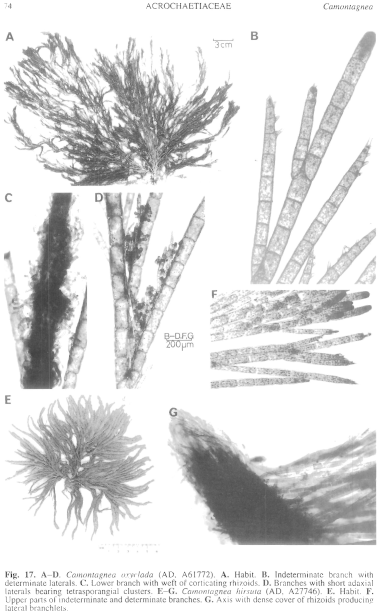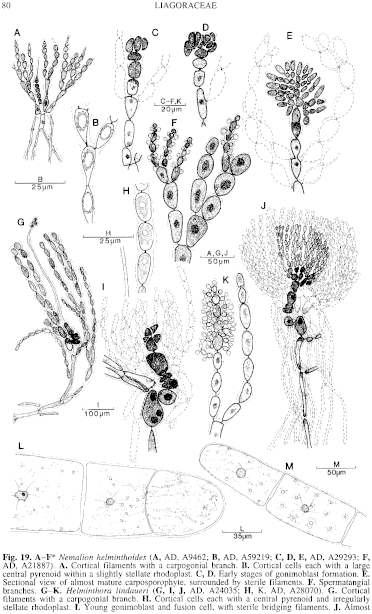|
|
|
|
|
|||||||||||
|
Electronic Flora of South Australia Species Fact Sheet
Phylum Rhodophyta – Class Florideophyceae – Order Acrochaetiales – Family Acrochaetiaceae
Synonym
Ballia hirsuta Wollaston 1968: 320, fig. 22J–L, pl. 7.
Thallus (Fig. 17E) dark red-brown, 5–14 cm high, with several shaggy, sparsely branched, terete axes; axial cells 50–60 µm in diameter, L/D 3–4, densely corticated with closely appressed rhizoids (Fig. 17G) bearing determinate branchlets and forming the hirsute covering; branchlets 2–3 mm long, branched 1–3 times, cells 30–60 µm in diameter and L/D
2–3, rhizoids (13–) 16–35 µm in diameter, cells L/D (1.5–) 2–3; branchlets (Fig. 17F) with 1–2 (–3) subterminal cells bearing unilaterally short, straight, one (rarely two)-celled spines. Holdfast fibrous, of matted rhizoids, 2–15 mm across; epilithic. Cells (Fig. 19M) uninucleate with a central, suspended, nucleus, rhodoplasts ribbon like with several pyrenoids in the subapical cell, lower cells with several stellate lobed rhodoplasts each with a central pyrenoid.
Reproduction: Reproduction unknown.
Type from Catamaran, Recherche Bay, Tasmania, upper sublittoral (Wollaston & Mitchell, 27.ii.1964); in AD, A27746.
Selected specimens: Amphitheatre Rock, West I., S. Aust., 10–20 m deep (Edyvane, 24.v.1982; AD, A52999). Green Point, Marrawah, Tas., lower eulittoral (Bennett, 29.i.1955; AD, A20623). Bicheno, Tas., lower eulittoral (Bennett, 6.ii.1955; AD, A20665).
Distribution: New Zealand (South and Stewart Is). West I., S. Aust., and around Tasmania.
Taxonomic notes: Goose Bay, S of Kaikoura, N.Z., drift (Womersley, 18.ii.1949; AD, A11499). Ringa Ringa, Stewart I., N.Z., drift (Womersley, 4.i.1966; AD, A29824).
The cell structure of C. hirsuta is very similar to that of the type species, but it differs clearly in habit and the covering of branchlets, produced from rhizoidal cells, along the axes. Records indicate that it is a shallow-water species, apart from the one deeper collection from West I., S. Aust.
References:
WOLLASTON, E.M. (1968). Morphology and taxonomy of southern Australian genera of Crouanieae Schmitz (Ceramiaceae, Rhodophyta). Aust. J. Bot. 16, 217–417, Plates 1–10.
The Marine Benthic Flora of Southern Australia Part IIIA complete list of references.
Publication:
Womersley, H.B.S. (14 January, 1994)
The Marine Benthic Flora of Southern Australia
Rhodophyta. Part IIIA, Bangiophyceae and Florideophyceae (to Gigartinales)
Reproduced with permission from The Marine Benthic Flora of Southern Australia Part IIIA 1994, by H.B.S. Womersley. Australian Biological Resources Study, Canberra. Copyright Commonwealth of Australia.
Illustrations in Womersley Part IIIA, 1994: FIGS 17 E–G, 19M.

Figure 17 enlarge
Fig. 17. A, B. Camontagnea oxyclada (AD, A61772). A. Habit. B. Indeterminate branch with determinate laterals. C. Lower branch with weft of corticating rhizoids. D. Branches with short adaxial laterals bearing tetrasporangial clusters. E–G. Camontagnea hirsuta (AD, A27746). E. Habit. F. Upper parts of indeterminate and determinate branches. G. Axis with dense cover of rhizoids producing lateral branchlets.

Figure 19 enlarge
Fig. 19. A–F* Nemalion helminthoides (A, AD, A9462; B, AD, A59219; C, D, E, AD, A29293; F, AD, A21887). A. Cortical filaments with a carpogonial branch. B. Cortical cells each with a large central pyrenoid within a slightly stellate rhodoplast. C, D. Early stages of gonimoblast formation. E. Sectional view of almost mature carposporophyte, surrounded by sterile filaments. F. Spermatangial branches. G–K. Helminthora lindaueri (G, I, J, AD, A24035; H, K, AD, A28070). G. Cortical filaments with a carpogonial branch. H. Cortical cells each with a central pyrenoid and irregularly stellate rhodoplast. I. Young gonimoblast and fusion cell, with sterile bridging filaments. J. Almost mature carposporophyte with sterile involucral filaments and descending rhizoids. K. Spermatangial branch. L. Camontagnea oxyclada (AD, A61772). Apical and subapical cells of an indeterminate branch, with rhodoplasts (with pyrenoids) and a central nucleus. M. Camontagnea hirsuta (AD, A27746). Apical and subapical cells of an indeterminate branch, with rhodoplasts (with pyrenoids) and a central nucleus. [A, C–G, I–K after Womersley 1965.]
* In the following drawings of Liagoraceae, sterile filaments associated with carposporophyte development are shown with broken lines.

|
Email Contact: State Herbarium of South Australia |

|